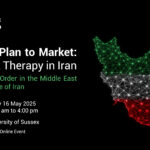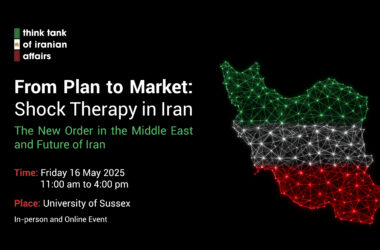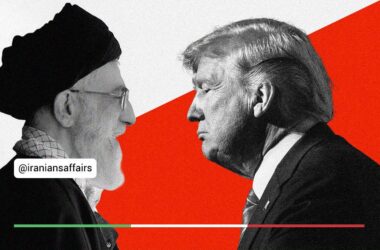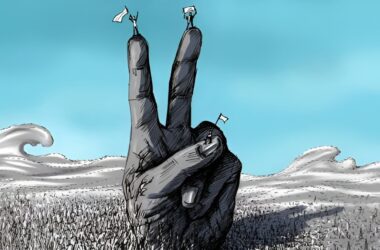In recent years, Iran has faced escalating crises in energy and water management, particularly in the areas of electricity, gas, fuel, and water resources. The government often uses the term “imbalance” to describe these challenges, portraying them as consumption-based issues, thus deflecting responsibility from its own structural inefficiencies and lack of investment. However, an in-depth understanding of the current situation and emerging trends is essential for developing systemic and sustainable strategies for Iran’s future. This article presents a comprehensive assessment of the latest status of energy and water in Iran.
Features of the Electricity Supply Crisis:
Iran’s total nominal electricity generation capacity stands at 110,000 megawatts (MW). However, the average operational efficiency of power plants is only around 60%, mainly due to the dominance of simple-cycle gas turbines, which require extensive downtime for overhaul nearly half the year. Converting these gas plants into combined-cycle systems and adopting basic optimization strategies could boost overall efficiency by 5–10%.
Iran also relies on hydropower plants for about 10,000 MW, but nearly half of this capacity is unavailable during the summer, when water levels drop. During peak demand in summer, the government attempts to utilize up to 90% of available power capacity. However, 25% to 30% of generated electricity is lost due to transmission and distribution inefficiencies. Therefore, in practice, the net usable capacity peaks around 70,000 MW, and annual average effective power delivery falls between 40,000 and 50,000 MW.
The most critical factor in rising electricity demand is cooling systems, which account for around 35% of peak consumption (25,000 MW). If supply were adequate, cooling-related demand could already exceed 40,000 MW, and is projected to surpass 50,000 MW within a few years, possibly reaching 70,000 MW within a decade—even with improved consumer efficiency.
The residential and commercial sectors together account for around 50% of electricity use annually, and up to 70% during peak consumption. Meanwhile, the industrial sector, which historically had a 35% share, must reduce usage during peak demand. Agriculture and public uses (like street lighting) account for 12% and 8% respectively, and also face increasing constraints.
A new and significant burden on Iran’s power grid comes from cryptocurrency mining operations. While the government officially acknowledges 2,000–3,000 MW in mining-related consumption, unofficial estimates suggest 5,000 to 7,000 MW. Moreover, Iran’s uranium enrichment program, which has expanded from 10,000 SWU (separative work units) to 110,000 SWU, likely requires an additional 1,000–2,000 MW—though official figures remain undisclosed.
Furthermore, Iran’s desalination plants, pumping stations, and inter-basin water transfer projects are adding further demand to the already fragile electricity system. Looking ahead, the transition to electric vehicles (EVs)—a global trend meant to reduce fuel use and pollution—will become a serious challenge for Iran, as its grid is ill-equipped to handle that additional load.
Despite all these pressures, Iran’s per capita electricity consumption is only half of the average in OECD countries. Even though energy prices are artificially low and many appliances and vehicles are inefficient, total per capita energy consumption remains 20–25% lower than developed nations. Thus, it is inaccurate to blame the Iranian public for overconsumption. Given Iran’s climate and the availability of cheap energy, a consumption level closer to OECD standards would actually be expected.
Globally, renewable energy sources are rapidly expanding. China has added over 1,100,000 MW of renewable power in just 15 years—more than 10 times Iran’s entire capacity. India has built over 50,000 MW of solar power in recent years. These expansions have been made possible by moderate investments and proper planning. Iran, however, has failed to establish meaningful cooperation with these nations for renewable development. Iran’s current renewable energy capacity (excluding hydropower) is less than 2,000 MW.
At the core of Iran’s electricity crisis lies a chronic lack of investment. Policy failures and institutional inefficiencies are not unique to the power sector, but their consequences are more visible and painful here for the public. For example, widespread blackouts during winter have been caused by issues such as:
• inadequate diesel and mazut storage,
• conflict between the Oil Ministry and Energy Ministry over natural gas allocation,
• failure to plan overhauls properly.
Even in crisis situations, the government could have avoided blackouts through timely imports of fuel. But instead, the regime chose the erosion of public welfare. Remarkably, some officials expressed shock when the state gas company opted to sell gas at higher prices to other sectors instead of supplying power plants.
Between 2011 and 2024, Iran added 40,000 MW to its nominal electricity capacity. Yet, due to worsening demand imbalance, it has not improved supply during peak demand. Projections suggest that electricity demand in summer 2025 will reach 77,000 to 85,000 MW, while the actual deliverable capacity remains 65,000 to 70,000 MW. This implies a shortfall of 15,000 MW, even under controlled conditions (with public holidays, adjusted programs, and lowered expectations).
Characteristics of the Natural Gas Supply Crisis:
Iran’s average daily natural gas consumption stands at approximately 600 million cubic meters (mcm), while the total transmission capacity of the gas network is around 650 mcm/day. The critical bottleneck emerges during peak winter demand, which can exceed 900 mcm/day.
In such periods, industrial and power plant sectors each account for roughly 300 mcm, and thus face severe supply constraints. Public and commercial buildings, including banks and government offices, consume around 15–20% of gas during peak periods. While shifting working hours can slightly reduce demand, the inflexibility of heating needs makes it harder to control consumption compared to electricity in summer.
As a result, government-mandated shutdowns of offices and schools—and even entire regions—have become common during winter. A portion of this gas shortfall is compensated by cutting gas supplies to power plants, which then results in increased electricity shortages, creating a vicious cycle. Encouraging people to switch from gas-based heating to electric heating is not feasible, given the fragile power grid.
Iran has storage capacity for fuel oils (diesel, mazut)—up to 4 billion liters—but this is often underutilized, and rising demand for diesel-fueled generators during blackouts has strained reserves. Despite government claims of fuel preparedness, most of the thermal reserves are unavailable during winter.
Medium-term solutions may include increasing field pressure, improving pipeline infrastructure, and importing gas from Russia or Turkmenistan. However, despite having massive gas reserves in the south, Iran’s mismanagement and under-investment have delayed proper development.
In the long term, many experts argue that Iran should electrify public heating, reducing reliance on natural gas altogether. Such a shift would require not only energy diversification, but also comprehensive investment and economic reform—both of which are stalled due to political decisions.
Iran’s over-reliance on just two main energy sources (oil and gas) has led to poor planning and excessive vulnerability. A transition to targeted, efficient electricity-based heating could eventually ease winter pressures—if combined with grid upgrades and demand-side optimization.
Iran’s average daily natural gas consumption stands at approximately 600 million cubic meters (mcm), while the total transmission capacity of the gas network is around 650 mcm/day. The critical bottleneck emerges during peak winter demand, which can exceed 900 mcm/day.
In such periods, industrial and power plant sectors each account for roughly 300 mcm, and thus face severe supply constraints. Public and commercial buildings, including banks and government offices, consume around 15–20% of gas during peak periods. While shifting working hours can slightly reduce demand, the inflexibility of heating needs makes it harder to control consumption compared to electricity in summer.
As a result, government-mandated shutdowns of offices and schools—and even entire regions—have become common during winter. A portion of this gas shortfall is compensated by cutting gas supplies to power plants, which then results in increased electricity shortages, creating a vicious cycle. Encouraging people to switch from gas-based heating to electric heating is not feasible, given the fragile power grid.
Iran’s Water Management Crisis: Beyond the Myth of “Drought”:
Iran’s domestic and sanitary water consumption is approximately 9 billion cubic meters (bcm) annually. Despite population growth, this number is not expected to rise significantly, due to improvements in efficiency and reduced leakage. Notably, much of Iran’s urban tap water is no longer drinkable, and is considered merely “sanitary” water. In regions such as central and southern Iran, this quality issue is more severe, prompting calls for separate infrastructure for drinking water versus general use.
In recent years, concerns over urban water shortages in cities like Tehran have emerged. However, these are more related to distribution inefficiencies and mismanagement, rather than actual scarcity. In fact, Iran’s water situation is highly localized: while some provinces like Yazd, Sistan-Baluchestan, and parts of Kerman face genuine water scarcity, other regions have ample reserves. This spatial variability, due to Iran’s vast geography and arid zones, calls for region-specific solutions.
To address water shortages in arid provinces, the government has focused on inter-basin water transfer and non-conventional sources (e.g. desalination). Although politically sensitive—such as the violent protests over water transfers to Yazd—these projects have been key in stabilizing supplies. Nationwide, however, drinking water shortages are not considered acute, and are often exaggerated for political or economic leverage, such as justifying megaprojects or land speculation.
Iran’s industrial water usage is under 3 bcm/year in terms of actual consumption, though withdrawals (for cooling or processing) can exceed 20 bcm, most of which is recycled. Large-scale industries like mining, oil refining, and petrochemicals are encouraged to source water directly from the sea, particularly in southern regions. Small industries, meanwhile, are expected to use treated wastewater or participate in water markets.
Treated wastewater and desalinated seawater are the two main non-conventional sources. Iran’s greywater potential is estimated at 5–6 bcm, enough to support urban greenery and some industrial demand. Desalination permits already exist for 30 bcm of seawater annually, with 6 bcm allocated for treatment, but only 600 mcm/year has materialized. Most desalination efforts are concentrated on the Persian Gulf and Gulf of Oman, with five major pipeline routes planned or underway.
Among these, the Yazd-Kerman pipeline is operational, and Fars and Khorasan lines are progressing. Desalinated water costs €1.5/m³ at source, and €4–8/m³ inland—making it viable only for high-margin industries. Despite this, the regime remains committed to nationwide water transport instead of relocating population and industries to coastal zones, a strategy widely considered inefficient and unsustainable.
The Agricultural Water Trap and Iran’s Groundwater Collapse:
Iran’s water crisis is most severe in the agricultural sector, where claimed annual consumption reaches 70–80 bcm. However, the Ministry of Agriculture argues that actual consumption—meaning water that reaches plant roots—is only around 30 bcm, with the rest classified as inefficient withdrawals, due to poor irrigation practices or water losses. The sector also includes rain-fed (dry farming) and mixed farming, which use less water than assumed.
Nevertheless, chronic over-extraction of water—especially from groundwater aquifers—has created a structural collapse. There are over 700,000 registered wells (with some estimates approaching one million), many of them unlicensed and shallow, yet the main damage comes from deep, high-volume wells that are state-approved. These industrial-scale operations have caused aquifer depletion and widespread land subsidence.
The cumulative groundwater deficit in Iran is now estimated at 143 bcm. Of 609 water basins, 410 are in critical or prohibited condition. In some parts of the country, land is sinking at a rate of 20 cm or more annually—up to 40 cm in central plains. This is five times the global average and threatens the structural integrity of major cities, including Tehran.
Iran’s unique geography necessitates some level of groundwater reliance, especially given the lack of perennial rivers. However, unlike surface water, groundwater is slow to recharge and less manageable. Unlike regions such as Europe or North America, there is no global model to guide sustainable use at this scale—making Iran’s situation even more precarious.
Despite these realities, water policy has often been distorted by data manipulation and politicized narratives. Investments in surface water infrastructure—such as well-placed dams and regulated flow systems—could have allowed for more productive agriculture even without tapping aquifers. However, short-sighted development policies, urbanization pressures, and unsustainable farming patterns have undermined that potential.
The situation is worsened by conflicting water rights, poor coordination between sectors, and outdated institutional frameworks. Iran lacks a unified authority for managing rangelands, water resources, environmental protection, and meteorological services. Data collection is fragmented, and strategic planning is often reactive, not proactive.
Ultimately, the regime’s refusal to adopt eco-economic principles, align with global best practices, or engage in serious investment reforms has deepened Iran’s water crisis. Without structural change, aquifer recovery is impossible, and rural depopulation, urban chaos, and national-scale ecological collapse are likely outcomes.
Fuel Supply Crisis: Gasoline, Diesel, and the State’s Multi-Phase Plans:
As of early 2025, Iran’s daily fuel production is as follows:
• Gasoline: 110 million liters
• Diesel: 130 million liters
• Mazut (Heavy Fuel Oil): 65 million liters
• Other oil products: ~50 million liters
Almost all of it is consumed domestically, while a portion—particularly diesel—is illegally smuggled to Pakistan and Afghanistan. To meet internal demand, Iran also imports 6 to 10 million liters of gasoline per day.
Without changes in consumption behavior, demand will grow by 3–5% annually, leading to an increasingly severe fuel shortfall in the next decade. The problem is aggravated by Iran’s urban sprawl, in which lower-income populations are pushed to satellite towns, forcing daily commutes to large cities. Coupled with poor public transit, people are locked into car dependence—fueled by cheap gasoline.
Following the deadly protests over fuel price hikes in November 2019, the government has frozen prices, choosing instead to ration supply and lower fuel quality. Up to 15 million liters/day of substandard gasoline is now produced in petrochemical plants, worsening urban air pollution. Still, the regime has held off further price hikes to avoid social unrest.
Nonetheless, gradual removal of subsidies for gas and electricity is already underway. Gasoline and diesel, however, are more politically sensitive. In the 2025 budget, the government proposes to raise jet fuel prices by over 10 times—but other fuels remain untouched.
To quietly phase out subsidies, the regime uses seasonal rate hikes—for example, increasing electricity prices in winter and gas prices in summer—when demand is lower, thus dampening public backlash. These increases are often regional and tiered, based on location (urban vs rural, central vs peripheral), consumption level, and household size.
Scenario 1: One Liter per Person per Day
One widely discussed plan is the “universal quota”: each Iranian would receive 30 liters of gasoline per month, priced at 1,500 tomans/liter (~subsidized). Surplus gasoline can be sold at a floating price (e.g., 10,000+ tomans) via intermediaries, markets, or state apps. This model shifts subsidy allocation from vehicles to people, benefiting non-car owners and rural populations.
Yet, many uncertainties remain:
• Who will handle sales and pricing?
• Will ride-hailing drivers receive extra quotas?
• What happens to diesel users and truck fleets?
Despite elite support, technical infrastructure is lacking, and security risks (e.g., hacking fuel databases) are high.
Other Scenarios: Regional, Tiered, and Multi-Phase Pricing
The regime is also considering:
• Zonal rollout (starting with border or major urban areas),
• Multi-price schemes (three gasoline prices: subsidized, semi-subsidized, and free-market),
• Phase-wise execution (keeping old system temporarily, gradually shifting to the new one).
This strategy would disperse public anger, buy time, and ease society into price normalization. While framed as “justice”, it is largely aimed at increasing state revenue and monetizing public goods under the guise of reform.
Air Pollution, Fuel Quality, and the Hidden Political Crisis:
Among all fuels, mazut has become a symbol of environmental decay. Although it provides only 8% of electricity generation, the mazut used in Iran contains over 3.5% sulfur—well above international standards, which require under 0.8%. Proper filters and emissions controls could reduce its harm, but Iran’s power plants lack modern scrubbing technology and operate without environmental compliance.
This issue is not limited to mazut. Gasoline and diesel in Iran also suffer from poor quality, due to aging infrastructure and lack of foreign investment. The government has failed to upgrade refineries, and even simple measures like installing smokestack filters have been neglected.
The air pollution monitoring system itself is dysfunctional. Monitoring stations are poorly located, malfunctioning, or lack modern sensors. Data is frequently hidden or manipulated. Since 2016, source-attribution data—which breaks down the contribution of cars, industries, and other polluters—has not been released.
Until recently, the entire pollution debate focused only on mobile sources (cars, motorcycles), while stationary sources like power plants and factories were ignored. The government’s urban transportation departments were tasked with air quality management—an odd assignment that skewed priorities and funding.
Today, though attention has shifted to stationary sources, there is still no reliable model for evaluating their contribution, especially regarding PM2.5 particles, which are the most harmful. Without accurate source data, effective policymaking is impossible.
Iran’s air pollution crisis, just like its crises in electricity, gas, water, and fuel, stems from systemic dysfunction. These are not just technical or financial problems—they are deeply political. Without structural reform, the crises will deepen, feeding into one another in a self-reinforcing loop.
The country needs:
• Reform of energy governance, with unified oversight of water, electricity, gas, and environmental affairs;
• Independent monitoring institutions, with transparent data reporting;
• Removal of rentier structures, and space for investment and innovation;
• Transition toward renewable energy, especially solar and wind;
• Regional water strategies, not centralized megaprojects;
• Market-based fuel pricing, accompanied by targeted subsidies and welfare support.
Most importantly, Iran must rejoin the global economic order. Without integration into global trade and finance, foreign investment, technology transfer, and environmental compliance will remain impossible.
The regime’s propaganda—about optimizing consumption, improving air quality, or achieving justice through subsidy reform—is widely seen as deceptive. While real solutions exist, they require political will, structural accountability, and public trust—all of which the current system lacks.
Until then, the wind remains Tehran’s best hope for clean air.

